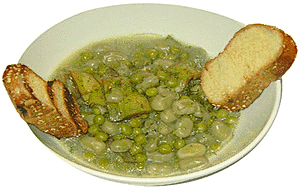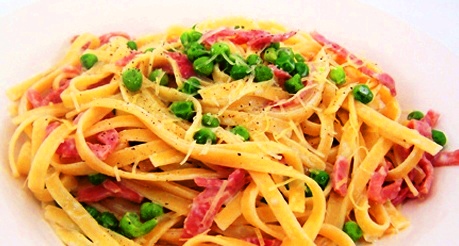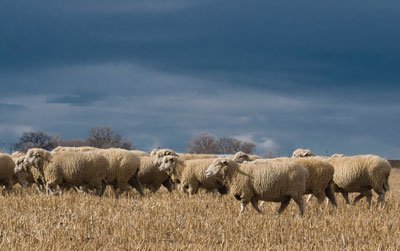As winter fades from memory, our appetites begin to yearn for fresh spring vegetables. The two earliest to arrive are asparagus [asparagi] and fava beans [fave]. For most of the U.S., these vegetables are best from late April through mid-June. Both share important status in Italian cuisine.
Fava beans
The only bean known in Italy for nearly 5,000 years was the fava bean. Italians from central parts southward to Sicily enjoyed these beans either fresh and young or dried and later soaked in water and cooked. It wasn’t until the discovery of the New World did Italians begin growing other varieties of beans, which during the late 16th Century were introduced into nearly all of Europe and are today an important part of the Italian diet.
Fava beans are an annual cool-weather crop. Italians eat fava beans raw, cooked, or dried (after reconstitution). In Tuscany, fava beans are eaten raw with some sea salt or simply grilled while still in their pods.
As the fava plants mature in late spring, their beans become drier, starchier, and tougher. At this point, they are dried and used later in soups and other dishes.
Traditional early fava bean dishes include:
- Ciauredda [Artichoke and Fava Bean stew]. Fresh fava beans are sautéed with onions, artichokes, and potatoes, and then formed into a stew. (Basilicata)
- Fave al Guanciale [Fava Beans and Pork Jowl]. The dish simply uses young fava beans sautéed in olive oil with onion and pork jowl. (Lazio, mainly Rome)
- Fave alle Acciughe [Fava Beans and Anchovies]. The fava beans are first boiled until al dente, and then combined with anchovy fillets, garlic, and marjoram. This mixture is loosely chopped and then white wine vinegar, salt, and pepper are added (Calabria)
- Fave con Salsa all’Aceto [Fava Beans in Vinegar Sauce]. The fava beans are first boiled, then sautéed in olive oil and garlic, and then blended with stale bread, white wine vinegar, grated pecorino, and fresh mint leaves. (Calabria)
- Pasta con le Fave [Pasta and Fava Beans]. Fava beans are added to sautéed pancetta and onion, along with marjoram, salt, and a bit of chili pepper. After adding tomato puree, the sauce is used to cover rough-cut egg pasta [maltagliati] (Abruzzo)
- Quadrucci con le Fave [Tiny Square Pasta and Fava Beans]. Cooked ham is sautéed with onion and mint leaves, with meat broth added, along with plum tomatoes and fresh fava beans. The broth is simmered for about an hour before the fresh tiny pasta squares are added. (Upper Lazio)
- Zuppa di Fave Fresche [Fresh Fava Bean Soup]. Fava beans are added to artichokes, fresh peas, onions, potatoes, asparagus, and pancetta are sautéed until very soft (Campania)
At Bellavitae, we are serving fresh fava beans my favorite way – Tuscan-style. We shell fresh fava beans, combine them with small cubes of fresh Pecorino Toscano DOP (young Tuscan pecorino), and drizzle liberally with Tuscan olive oil. Nothing says spring more than this dish.
Dried fava beans are used mainly in soups and purees. But here are a couple of other traditional Italian dishes that use dried fava beans:
- Fave e cicorie [Fava Beans and Chicory]. Dried beans are soaked overnight, then cooked for about three hours in lightly salted water. The beans are then crushed and drizzled with olive oil. The crushed beans are then mashed with a wooden spoon and served on a bed of cooked chicory and drizzled with more olive oil. (Puglia)
- Panelle di fave [Fava Bean Fritters]. Dried fava beans are soaked overnight and then simmered in salted water with onion and fennel for about three hours. The mixture is passed through a sieve. This “dough” is then rolled out very thick and left to cool. Then 1” by 2” strips are fried in olive oil until golden. They can then be dusted with chili pepper flakes. (Sicily)
Asparagus
Asparagus is found throughout Italy and the vegetable is served raw, grilled, fried, boiled, dressed with sauces, or deep-fried in batter as part of a fritto misto. There’s even an Italian saying – attributed to the Roman Emperor Augustus – “Velocius quam asparagi coquantur.” [Let it be done quicker than you would cook asparagus].
Asparagus is one of the oldest domesticated vegetables. It grew wild along the Nile in ancient Egypt. The Greeks enjoyed the vegetable and introduced it to the Romans. Asparagus was believed to be an aphrodisiac – the name comes from Greek meaning “to swell to be ripe.”
The best-known variety is probably Asparagi Bianchi del Bassano, the white asparagus from the town of Bassano del Grappa in the Veneto. It is grown entirely underground by about 100 local farmers. They deliberately keep the plants in the dark – a process known as etiolation – as a result, no chlorophyll develops in the spears, which remain white. J.S. Marcus wrote an interesting article in The Wall Street Journal about how Italians go wild for this variety beginning in early March each year that dates back to the mid-16th Century.
Classic Italian dishes using asparagus include:
- Asparagi al Gorgonzola Dolce [Asparagus with Gorgonzola Dolce] The asparagus are boiled until done, then placed in a baking dished, covered with Gorgonzola Dolce and butter and baked until the cheese is browned. (Piedmont)
- Asparagi con le Uova in Cereghin [Asparagus with Fried Eggs]. Asparagus spears are boiled upright until bright green. After drained, they are plated and sprinkled with Parmigiano-Reggiano. Eggs that have been fried sunny-side up are placed on top, melting the cheese in between. (Lombardia)
- Asparagi di Bassano con Salsa di Uova Sode [White Asparagus with Egg Sauce] Asparagus spears are boiled upright. When done they are covered with a sauce made of hard-boiled eggs, lemon juice, anchovies, and capers. (Veneto)
- Asparagi Selvatici in Umido [Braised Wild Asparagus] Here’s a Sicilian riddle:
- Indovinello: “Mastru tanu, chi faciti ‘nta ‘ssu chià nu? Nun manciati e nun viviti e chiù longu vi faciti!” [“Master Gaetano, what are you doing in that piazza? You don’t eat, don’t drink, and all the time just grow longer!”].
- “Risposta: “l’asparago selvatico”. [Answer: “I’m wild asparagus”].
Sicilians adore wild asparagus, which has a pleasantly bitter taste. This recipe calls for wild asparagus tips sautéed in an earthenware pan with white wine, tomato paste, and salt. (Sicily)
- Frittata di Asparagi [Open-faced Omelet with Asparagus and Parmigiano-Reggiano] Beaten eggs fried open-face style in butter with cooked asparagus, grated Parmigiano-Reggiano, salt, and pepper. (Emilia-Romagna)
- Riso e Asparagi [Rice and Asparagus] The asparagus are placed in salted boiling water with the stalks standing in the pot. They are then simmered for about 15 minutes. The stalks are discarded for another use. The remaining water is returned to a boil with Arborio or Carnaroli rice added. Before serving, the asparagus tips are added, along with butter and Taleggio. (Lombardia)
- Risotto di Scampi agli Asparagi [Risotto with Shrimp and Asparagus] Asparagus are boiled and the tips removed. The stalks are put through a food mill and added to the reserved cooking liquid. The shrimp are shelled. The shells and heads are boiled with a carrot, onion, celery, and bay leaf. The strained liquid is added to the asparagus liquid. The resulting broth is used to make the risotto. (Veneto)
- Zuppa di Asparagi [Asparagus Soup]. Asparagus is sautéed in olive oil with garlic. Beef broth is added. When the asparagus has cooked bright green, beaten eggs, grated pecorino, and parsley are added. The mixture is poured into bowls over slices of bread (Calabria)
At Bellavitae, we are offering fresh asparagus two ways:
- First, we simply grill it, brushing on olive oil.
- The second is a method from the small northwest Italian region of Valle d’Aosta in the Alps. We take bundles of asparagus, add strips of fontina cheese, and wrap in a slice of prosciutto. We top it with a bit more fontina, and then bake it in the brick oven.
The growing season for both fava beans and asparagus is very short – some six or seven weeks. Then it’s on to other vegetables: first peas, then fresh basil (pesto!), and, well, I’m dreaming about juicy summer tomatoes.
Meanwhile, celebrate spring in New York – Italian-style at Bellavitae.
.




